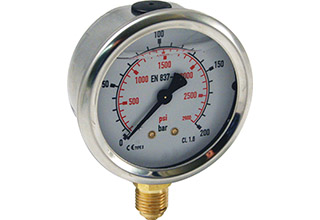By Josh Cosford, Contributing Editor
 A pressure gauge is a fluid intensity measurement device, without which, the amplitude of hydraulic or pneumatic energy would be guesswork. Pressure gauges are required for the set-up and tuning of fluid power machines, and are also indispensable in troubleshooting them. Without pressure gauges, fluid power systems would be both unpredictable and unreliable.
A pressure gauge is a fluid intensity measurement device, without which, the amplitude of hydraulic or pneumatic energy would be guesswork. Pressure gauges are required for the set-up and tuning of fluid power machines, and are also indispensable in troubleshooting them. Without pressure gauges, fluid power systems would be both unpredictable and unreliable.
Hydraulic pressure gauges are available to measure up to 10,000 psi, although maximum hydraulic pressure is typically in the 3000-5000 psi range. Hydraulic gauges are often installed at or near the pump’s pressure port for indication of system pressure, but can be installed anywhere on the machine where pressure needs to be monitored—especially if sub-circuits operate at pressure different from pump pressure, such as after a reducing valve. Often, pressure-reducing valves have a gauge port to tap into, allowing you to directly monitor its downstream pressure setting.
Pneumatic and compressed air systems are also rife with gauges, as pressure is also measured in many locations throughout the system. Pressure is measured at the receiver(s), as well as at every FRL or stand-alone regulator in the system. Sometimes pressure is measured at pneumatic actuators as well. Typically, pneumatic pressure gauges are rated for not much more than 300 psi, although typical systems run around 100 psi.
Pressure is measured in three ways—absolute, gauge and vacuum. Absolute pressure is a measure of actual pressure including ambient air, which is zero-referenced with a perfect vacuum, but can be as high as 14.7 psi at sea level. Absolute pressure readings are considered in applications interacting with ambient air, such as the compression ratio calculation for flow (cfm) requirements. Gauge pressure is zero-referenced against ambient pressure and is used in most applications operating in, but not with, ambient air, such as in fluid power systems. Disconnected from equipment, gauge pressure will read zero. Finally vacuum “pressure” is expressed in Torr, or referenced against ambient pressure, as with “in.-Hg” (inches of mercury) units, which measures pressure below ambient.
Most gauges in the fluid power industry are of the Bourdon-Tube type. They consist of a semicircular and flat tube of metal, fixed at one end and attached to a sensitive lever mechanism at the other. As pressure increases inside the tube, the force of the fluid attempts to straighten out the curved tube. The tube then pulls away from the lever, which being connected to the needle on the display, shows the pressure at the fluid port.
Most pressure gauges in North America come with a 1⁄4-in. NPT male, but SAE thread is gaining popularity. The use of test-point adapters at various locations on the hydraulic system allows for measurement during troubleshooting without having to purchase dozens of pressure gauges. The test-point fitting attaches to the gauge, which can be screwed onto the test points throughout the circuit, allowing you to connect under pressure to measure at various points in the system. Most gauges are 21⁄2 in. in diameter, and can be either top-mount or panel-mount styles. However, gauges are available in every size, material and construction imaginable, so if you require something for a unique application, a pressure gauge probably already exists that will fit those needs.

Thank you for sharing the article ! How to alleviate the pressure spike at startup that can damage the sensor causing premature failure ?